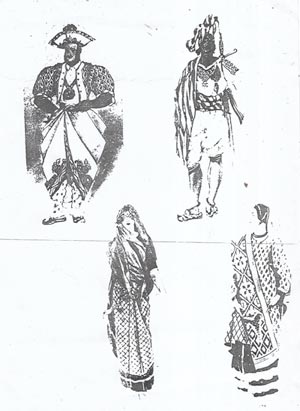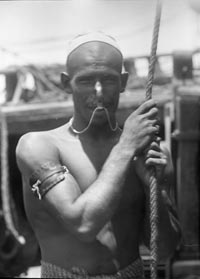‘The Pearl Fishers’: From Mexico to Sri Lanka, in search of the exotic

The original sketches of the costumes were Sri Lankan in many of the details
From September 10 -18, an exhibition of 19th century photography will be on at the Faculty of Arts, University of Jaffna. One of the highlights of the exhibition will be a selection of images of the activities of the pearl fisheries off the coast of Mannar.
At the preview of an identical exhibition held in January this year of photographs from the E. A. Hornel archival collection provided courtesy the National Trust of Scotland and displayed at the Harold Pieris Gallery from January 13-16, a few bars of music were played. The exhibition was partly funded by the National Trust of Scotland, and the British Council Colombo and hosted by the National Trust of Sri Lanka.
Only a handful of those assembled, recognised that the music was from the opera – The Pearl Fishers by Georges Bizet.
It is intriguing that the opera composed by Bizet (1838-1875) was set in Mannar, in the remote northwest coast of Sri Lanka. The selection of the setting was not that simple or straightforward, as it seemed. Only a few years ago musicologists discovered that the original opera was first set in Mexico and not as presently attributed to Sri Lanka. Was it Bizet himself or the librettist who later decided that the true location was in northwest coast of Sri Lanka? Most probably, Bizet was indifferent and did not care where the setting was to be.
In the mid-19th Century in an ideal opera, the plot would be largely centred to please opera aficionados almost comparable to present-day Hollywood movies. The plot for most operas ran along the following lines.
Most often the enthusiasts would prefer it to be set in a distant tropical country giving the composer as well as the designers of costume and sets freedom to take in the most exotic, though not always authentic features to dramatise the opera.
The plot would usually revolve around a noble savage or slave with a vestal virgin to lend the composer justification to include a chorus of vestal virgins.
It was then thought it was ideally suitable if they were Indian, Middle Eastern, Egyptian or South American in origin.
All of these features were to be incorporated with a scene of a dramatic massacre and the death of one or both of the ill-fated lovers. To maintain the excitement at a high pitch, a priest with a religious cult was almost a ‘must’ as a part of the dramatic death scenes.

Pearl diver from Mannar
Bizet was fretting over the very short time allotted to him to compose the music for this full-length opera. Commissioned by Leon Carvalho, the opera manager of the Theatre-Lyrique, it had to be ready within six months by September 1863 for the first performance on stage.
Bizet even confessed to his friend, the well known composer Charles Guonod that the actors who played the part of so-called ‘Hindus’ were originally to be cast as American Indians based on the assumption of the organisers that the pearls were fished out of a site supposedly close to a Mexican seaport. Later, when casting the actors as American Indians, it was thought not very convincing and most unlikely to be accepted by the audience. It was then the management of the opera decided that the scenes would be re-set in Sri Lanka.
The libretto (text of the opera) – an important ingredient in the work was never found. It is considered to be lost or destroyed.
Born in 1838, Georges Bizet was a prodigy. By the time he was 20, he had won several musical awards but even after winning the Grand prix de Rome he returned without any commission.
The Theatre-Lyrique was one of the most famous opera houses in Paris. Opera Manager Leon Carvalho was an imaginative entrepreneur who knew what his audience would best like and respond to. Carvalho got together two of his favourite librettists – Michael Carre and E. Cormon to draft the most exotic story.
In April 1863 he requested and commissioned Bizet for the operatic performance by September, though Bizet protested that the time was too short.
Gounod who was often counselled by Carvalho appealed to Bizet not to reject the commission: “imitate the tortoise not the hare. By yourself you will be alone today but you will have the world around you tomorrow.”
Strangely in the first performance of The Pearl Fishers in 1863, it was likely looking at the images that the costumes of the lead actors were authentic. The original sketches by the designer were well researched and essentially the costumes were Sri Lankan in many of the details. However over the years these costumes have tended to be more of an Indian style of attire such as sarees, dupattas and shalwars.
Bizet died without achieving much recognition at the early age of 37. Although he composed several other operas such as The Fair Maid of Perth (1867), and Djmileh (1872), these had less appeal.
It was Carmen (1875), that became universally popular and which remains the opera that we most associate with Bizet. Styled as a Spanish gypsy opera, it was set in Seville and performed in four acts. Its success was not immediate and the composer died three months after its first performance in 1875.
Although at the very beginning there was public indifference to The Pearl Fishers, there was one composer who believed that it was a masterpiece on its own right. Hector Berlioz (1809-1869) saw it three times and thought it was a tour de force. “The rhythms are one of those things one doesn’t dare write nowadays. The score does M. Bizet the greatest honour. So, we shall be forced to accept him as a composer.
Even though The Pearl Fishers has little to do with the reality of the pearl fisheries in Mannar – the composer paid little heed to the music and rhythms of Sri Lanka – it is still a great opera and placed Sri Lanka squarely on the world map.
From the 17th century (200 hundred years before Bizet’s lifetime), the French were obsessed with seizing Sri Lanka by military force. The French naval fleet was based in Pondicherry, South India. These maritime territories were under Dutch occupation when the French forces wrested control and occupied them for a few weeks from March-July1672, before they were ousted.
The French Navy made another attempt, and this time under the orders of Napoleon, occupied Trincomalee again from August 1782 to January 1783, but soon after the harbour was retaken by the British.
(Ismeth Raheem is President, The National Trust, Sri Lanka)
Searching for an ideal partner? Find your soul mate on Hitad.lk, Sri Lanka's favourite marriage proposals page. With Hitad.lk matrimonial advertisements you have access to thousands of ads from potential suitors who are looking for someone just like you.


